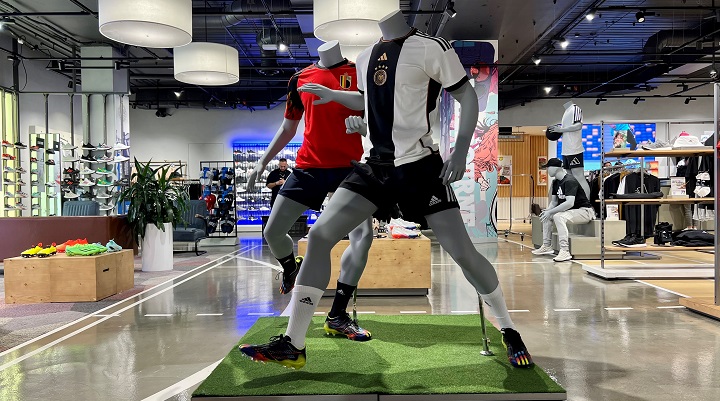The 2022 FIFA World Cup will come to an end this weekend, with the final match between Argentina and France to be played at Lusail Stadium in Qatar on Sunday. And despite the public outcry over the host nation’s human rights record in the lead-up to the event, it doesn’t seem to have dampened consumers’ interest in the tournament, judging by their spending habits. Around the globe, retailers from China’s JD.com to Britain’s electronics chain AO World have reported seeing a sales boos
oost from the World Cup, but perhaps none more so than sportswear giant Adidas, which is the main sponsor of the event.
“Adidas historically has been a strong supporter of the World Cup and so we tend to see a natural increase in sales in our football category throughout both the lead-up and the duration of the World Cup,” Alex Morgan, head of Adidas’ retail stores in Australia, told Inside Retail.
“There was a lot of noise and excitement locally, particularly after a tough few years where these types of events weren’t able to be facilitated in the way that they previously were.”
According to Morgan, match balls are typically Adidas’ most popular product with the highest sell-through, but its national team jerseys also receive a lot of attention, particularly as certain countries progress further into the World Cup.
“For example, Messi has said that 2022 would be his last World Cup, and to have the Argentina jersey as a part of our assortment was something that was really special and definitely garnered a lot of attention from the diehard soccer fans,” Morgan said.
Kits are also big business for Ultra Football, a soccer specialist with stores in Sydney and Melbourne, which held a first-of-its-kind runway event to unveil Adidas’ new jerseys in the lead-up to the World Cup.
“We want to make sure that we’re the first to really mix fashion and sport, because the consumer does anyway,” Matthew Adams, Ultra Football’s general manager, told Inside Retail.
Men’s tournament just the warm-up
Interest in soccer, or football as most of the world calls it, is growing in Australia, where sports such as Australian rules football, rugby and cricket have traditionally been more popular.
“When I was growing up as a kid, I could watch one game of football a week on TV, and now, every kid can watch every game on their iPhone,” Adams said. “Access to the game has changed completely.”
With Australia and New Zealand set to co-host the women’s World Cup next year, retailers like Adidas and Ultra Football see an opportunity to build on this momentum.
“There is definitely a growing interest in soccer in Australia, particularly with the women’s World Cup taking place here next year,” Morgan said.
“To be able to support the World Cup as a brand and continue to build on that engagement with our customers and the wider community is very exciting. A lot of work goes on behind the scenes and starts very early in terms of preparation from both a brand and marketing perspective. There are certainly some very exciting things in the works!”
Similarly, Adams said that he has had discussions with FIFA about what a retail partnership around the women’s World Cup could look like.
“It’s an interesting topic because we were a brand that was slow to adapt to the women’s game,” he admitted.
“The angle we’ve tried to take is rather than just jumping on and saying, ‘We’re coming along for the ride,’ we really want to look at the journey of [the women’s team], who they are, what they’ve gone through. We really want to help build that profile, and then, through that, we’ve started to find out what product specifically [female shoppers] want.”
‘Don’t shrink and pink it’
“One of the things we’ve found is that [women] don’t want their own colour,” Adams said. “We call it, ‘Don’t shrink it and pink it’. They want to be in the ‘men’s boot’ of the moment. They want to be in the same colour as all the global stars, but we need to have a better way of getting their size.”
Ultra Football is working with Nike and Adidas to offer football boots and other products in a greater variety of sizes and fit profiles in Australia, but it’s not going to happen overnight.
“It takes time, because a brand has to change the way they produce and how they produce. It probably takes 12 months to come to life, but you’re starting to see it now,” he said.
For instance, he noted that national team jerseys are generally available in the same style for both men and women now. At the end of the day, it’s all about choice, as some female players prefer the less fitted style of the men’s kits, perhaps because that’s all that was available to them in the past.
“We had a girl come in-store and she gave us some pretty hard feedback about the store journey and experience about three years ago,” Adams explained.
“It wasn’t necessarily associated with what we had created, but rather than just reject it, we said, ‘Let’s bring her and all her friends in to understand what they’re seeing.’”
It was a useful exercise to understand what female customers really want from a soccer specialist, and it came at a crucial time for Ultra Football, with the women’s World Cup just around the corner.
“There’s still a long way to go,” he said. “I think we’re still probably five years off getting it right, but it’s something that we’re working on really hard.”

